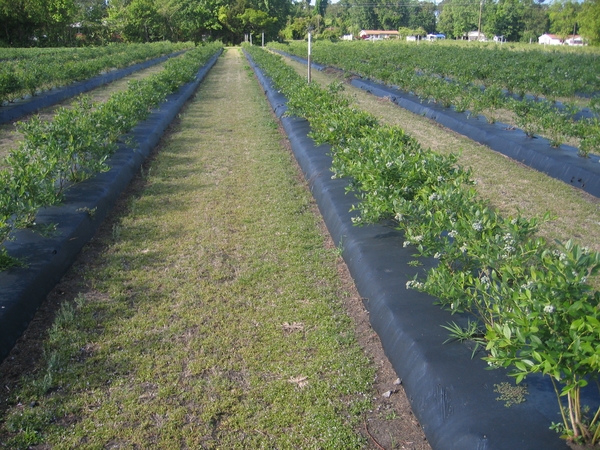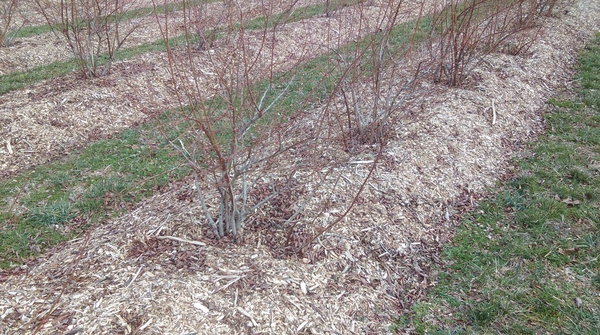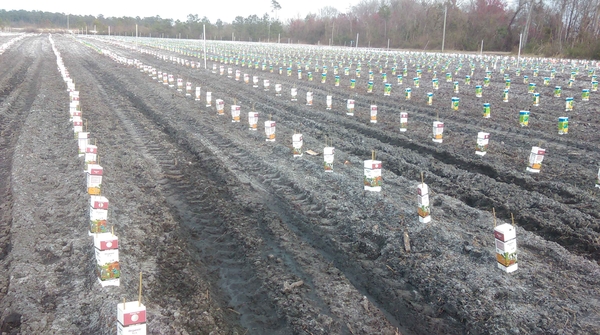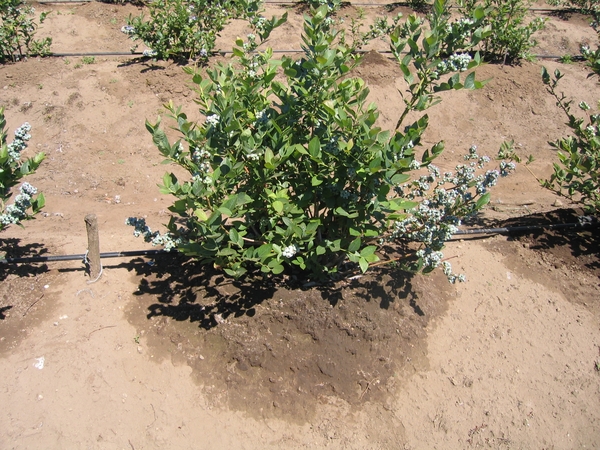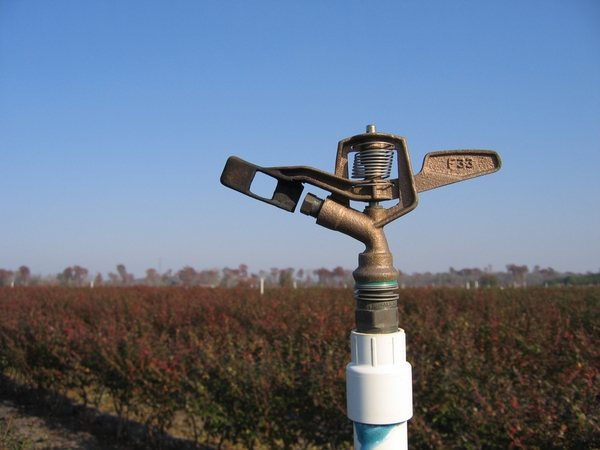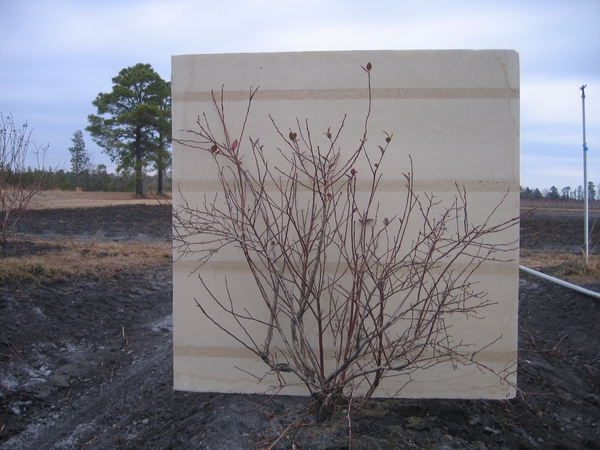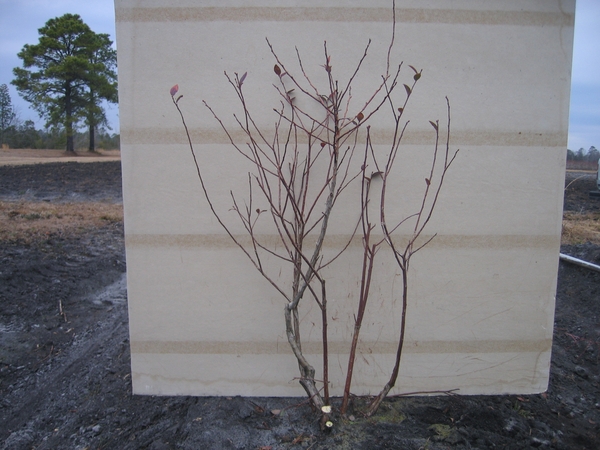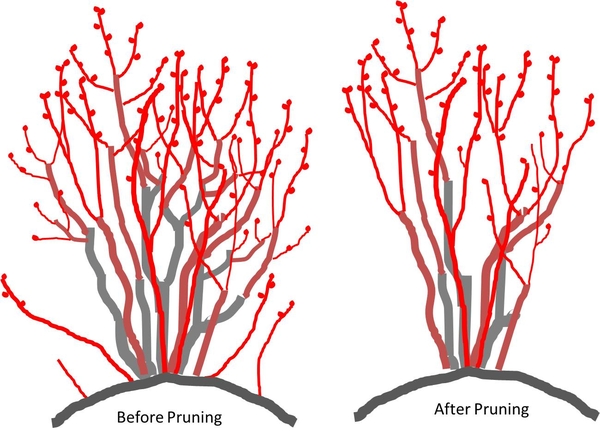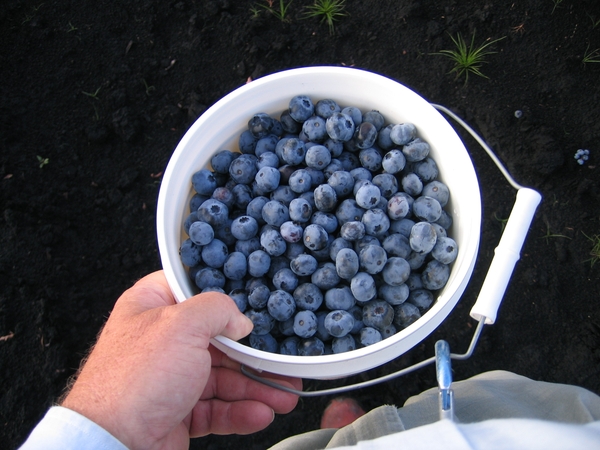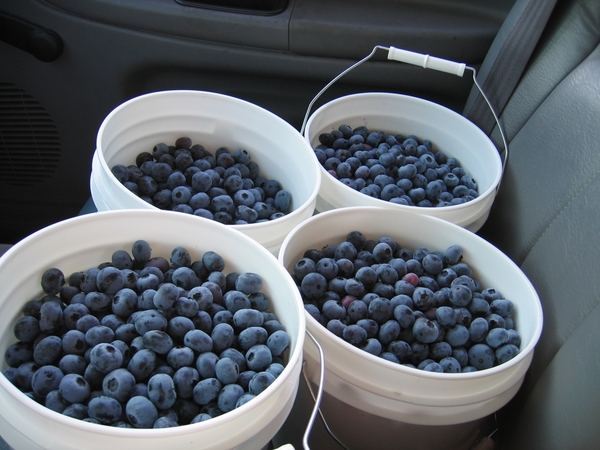Introduction
Blueberries are a native North American fruit, and North Carolina is one of the largest producers of highbush blueberries. Although large-scale commercial production is mostly limited to southeastern North Carolina, blueberries can be grown anywhere in the state if the right blueberry species and proper soil modifications are used. Limiting factors include pH, water availability and cold-hardiness.
Soil pH
Blueberries require a lower pH than many other small fruit crops. A soil test is highly recommended before planting to determine pH and the amount of humic matter (%HM) in the soil. Apply wettable sulfur (90% S) if pH is above 5.3 for rabbiteye blueberries or above 5.0 for highbush blueberries. Use 1.0 pound (2.5 cups) per 100 square feet on sandy soils to lower pH by 1 unit (for instance, from 6.0 to 5.0). Apply 2.0 pounds per 100 square feet for the same amount of pH lowering on heavier soils containing silt, clay or more than 2% organic matter. Try to achieve a pH of around 4.8; too much reduction can be detrimental to bush growth. Apply sulfur at least 3 to 4 months before planting, and take another soil test before planting. If pH is still above the acceptable range, additional sulfur can be applied. Pine bark (pH 4.5) can be added to the soil if humic matter is low.
Organic Additions
If the soil contains less than 2% organic matter, the incorporation of peat moss or well-decayed pine sawdust or pine bark mulch (preferred) will improve plant survival and growth. Establish the rows on ridges to provide the required drainage. Apply 4 to 6 inches of the organic material over the row in a band 24 inches wide and incorporate thoroughly using a roto-tiller to a depth of 6 to 8 inches. Preparing the beds in the fall will allow planting earlier in the season (late Feb. to late March depending on the location). If the organic material is incorporated in the fall, any sulfur required to lower the pH can be added at the same time. Avoid opening a furrow, adding the organic material and planting directly in the pure organic material. Water and nutrient management is likely to be difficult in the pure organic material and plants are more likely to become weak and die.
Organic material, such as bark, wood chips, sawdust or pine straw as a 3- to 4-inch mulch on the surface around the bushes after planting results in more uniform soil moisture, reduces soil temperature and generally promotes better bush growth and survival. Pine bark, chips or sawdust have a pH of 3.5 to 4.5 and are more desirable than the same mulches from hardwood with an associated pH above 5.0. However, hardwood mulches on the surface have been satisfactory. Avoid sticky hardwood sawdust that will "seal" the bed and prevent water infiltration. Do not pile mulch too deeply in the crown of the plant as this will be detrimental.
Weed barrier fabrics have been used successfully for blueberry production and can provide a critical weed control advantage during establishment, especially for organic growers where conventional herbicides cannot be used. Weed mat is applied after the beds are amended with fertilizer and mulch, then the bushes are planted through individual planting holes cut through the fabric. If drip irrigation is used it is generally placed under the barrier fabric prior to planting. Unused surplus waxed beverage cartons (see image) can be repurposed to shield plants from herbicide sprays.
Site Selection and Drainage
Select a site in full sun in a well-drained soil. Look for a convex site with good drainage in all directions, rather than a concave (dished-out low area) where water will stand on or just under the surface. Blueberries do not tolerate anaerobic soils -- good soil aeration is critical. On most sites, blueberries will perform better on a raised bed or row as opposed to planting "flat'. Provisions for drainage (raised beds, row orientation, site selection) must precede planting. Soil maps or observing the soil profile may be helpful in predicting internal drainage. However, digging a "dry well" is the most effective way to assess internal soil drainage. Dig hole(s) 6 to 8 inches deep and observe the water level following heavy rains. Water should not remain in the hole for more than 24 hrs; otherwise, select another site or plant on ridges high enough for the water level to reach 6 to 8 inches deep within 24 hours.
Irrigation
In most seasons and on most soils, irrigation is absolutely essential the year of planting. A system using micro-sprinklers is recommended as more efficient than point-source drippers. Even 2 drippers per plant often do not wet enough of the soil surface; however drippers may be more practical than microsprinklers where well capacity is low, or in areas of high foot traffic where pickers step on (and break) the exposed microspnnklers. At least 50% of the area under the drip line should be wetted. The irrigation must be designed for the higher output of micro-sprinklers (about 10 gal per hr) compared with 1 or 2 gal per hr for drippers; therefore well capacity may dictate the type fo system that is most appropriate. Align the micro-sprinklers to avoid saturated soil around the crown of the bushes. The use of automatic timers on drip or microsprinkler irrigation systems can result in shallow root systems and root rotting if systems apply water daily. Apply irrigation no more than once every two days to reduce the chances of root-rot infection. If the grower has no choice but to establish the planting on a low-lying site prone to problems with frost during the early spring (during bloom), then overhead sprinkler irrigation should be installed to provide frost protection and supplemental moisture. Overhead irrigation for freeze protection requires a large volume of water (68 gallons of water per acre per minute x 36 hours for three nights of protection) and generallly requires a surface water source rather than a well.
What Species
Both highbush (Vaccinium corymbosum) and rabbiteye (V. virgatum, syn. V. ashei) types of blueberries can be grown in the Coastal Plain and Piedmont. However, only highbush will consistently survive the minimum winter temperatures below 10°F that regularly occur in the mountains -- for this reason, rabbiteye blueberries are not recommended for planting above 2,500 ft elevation in western NC. While less winter cold-hardy, rabbiteye blueberries are more drought and heat resistant and will tolerate a wider range of soil types than highbush, making them easier to establish and grow successfully in the Piedmont and on the drier soils of the Coastal Plain than. More recently, a group of varieties referred to as southern highbush have been released. These varieties are intermediate between highbush and rabbiteye in soil and climate adaptation. Because of their vigor and soil adaptability, rabbiteye blueberries are the best choice for most soils below 2,500 ft elevation in NC.
Varieties
Highbush varieties begin ripening in mid-May in the southeastern Coastal Plain and in early July in the Mountains. Rabbiteye varieties begin ripening in mid-June in the southeastern Coastal Plain. More than one rabbiteye variety should be planted to provide the cross-pollination required for maximum yields. Following are varieties in order of ripening from early to late that have been grown successfully and are recommended for homeowners and pick-your-own operations:
Coastal Plain (for low elevation, high %HM soils) - Highbush: 'Duke', 'Jersey'; Southern highbush: 'O'Neal', 'New Hanover', 'Legacy'
Coastal Plain, Piedmont and Foothills (drier upland soils) - Rabbiteye: 'Climax', 'Premier', 'Centurion', 'Columbus', 'Ira', 'Tifblue', 'Powderblue', 'Onslow'; Southern highbush: 'O'Neal', 'New Hanover', 'Legacy'
Mountains above 2,500 ft - Highbush: 'Duke', 'Sunrise', 'Echota', 'Blueray', 'Bluecrop', 'Toro', 'Berkeley', 'Jersey'
Planting
- Plants - Bare-root nursery plants that are 2 or 3 years old and 12 to 36 inches tall will transplant well. The roots must be kept moist at all times between digging and replanting. Dormant 1-3 gallon potted plants are more expensive but prefered for their better survival rate. break up the roots on potted plants so that the root ball is no longer in the shape of the pot, prior to planting.
- Time - Late winter (Feb-Mar) as soon as the soil can be worked is best for bare-root plants; Fall (Nov-Dec) planting has been successful on sandy soil in the southeastern Coastal Plain with bare-root plants and in the other areas with potted plants.
- Spacing - Highbush 4 to 5 ft in the row and 8 to 10 ft between rows and; rabbiteye 6 ft in the row and 10 to 12 ft.
- Depth - In raised beds or bedded-up rows (see pictures), plant to the same depth as the plants were growing in the nursery if organic mulch will be applied on the surface. Without mulch, plant 1 to 2 inches deeper to allow for soil settling. Firm the soil around the plant with your feet and water thoroughly.
- Cut Back - Prune approximately 2⁄3 of the top growth on bare-root plants and 1⁄2 on potted plants leaving only 1 to 3 of the most vigorous upright shoots and remove any remaining flower buds (plump rounded buds).
Fertilization
- Use caution - Blueberries are easily damaged by excess fertilizer. Apply the recommended amount and allow 4 inches of rain or an equivalent amount of irrigation between applications.
- First year - Do not fertilize immediately after planting, wait until the first leaves have reached full size, then apply 1 Tbs of a special azalea fertilizer, 12-12-12 or 10-10-10 within a circle 1 ft from the plants. Repeat applications at approximately 6 week intervals depending upon rainfall or irrigation until mid-August in the Coastal Plain and mid-July in the Mountains. Use 1⁄2 Tbs of ammonium nitrate instead of the complete fertilizer for the second and subsequent applications if phosphorus was above 60 on the soil test.
- Second year - Double the first year's rates, but increase the circle around plants to 11⁄2 ft . Make the first application when new growth begins in spring.
- Bearing plants - When growth begins in the spring, apply 1 cup of complete fertilizer such as 10-10-10 within a circle 3 ft from the plant. If more vigorous growth is desired, sidedress with 1⁄4 cup of ammonium sulfate at 6 week intervals. For mature bushes, 6 to 12 inches of new growth is adequate, additional growth must be pruned away. This pruning may result in a loss in production, but it is necessary to keep the plants from becoming excessively large. Determine sidedressing requirement based on the amount of shoot growth and bush color.
- Lowering pH - If the soil pH is slightly high in an established planting based on a soil test; then sidedress with ammonium sulfate rather than ammonium nitrate. If the pH is 0.5 units or more above the acceptable range, apply wettable sulfur in a narrow band under the drip line of the bush at the rate of 0.1 pound per bush to lower pH 1 unit.
Weed Control
- Mulched - If mulch is applied following planting and replaced at the rate of 1 inch per year, few weed problems should develop. Hand pull or hoe the occasional weed growth. If row middles are in sod, mow often to reduce invasion by runnering grasses and weed seeds into the mulched area.
- Not mulched - Avoid deep cultivation since blueberry roots are very near the surface. Hoe no more than about 1 inch deep. In addition, hoe often (once every 2 weeks) when weeds are germinating to reduce competition with bush growth and to prevent disturbing the roots that will occur when large weeds are removed.
- Herbicides - Pre- and post-emergent chemical herbicides are registered for use in controlling weeds in blueberry plantings. Please contact your local county extension agent for current recommendations.
Pruning
- Highbush - If the plants are cut back severely as recommended following planting, little pruning will be required the second year except removing all flower buds and any weak, damaged or diseased growth. Use a similar pruning strategy the third year with the exception that several flower buds can be left on vigorous shoots. In the fourth year, the bush should be 4 to 5 ft tall and capable of handling a crop, but carefully thin flower buds to prevent overfruiting and severe permanent bending of young canes under the fruit weight. When bushes are mature, remove old canes that are weak, diseased or damaged; cut back tall, vigorous shoots to force branching at a lower level and to control bush height; and thin fruiting shoots to reduce the number of flower buds by about 50%. Prune during the dormant season. Late winter is most desirable, especially in the Mountains.
- Rabbiteye - During the first 3 years, pruning is very similar to highbush; however, excessively tall and limber shoots will need cutting back to stimulate branching and strengthen the shoot. With mature bushes that are excessively vigorous in spite of low rates of fertilization, cutting back the excessively vigorous shoots in late July will help control bush height and increase yield. Winter pruning of mature bushes is also similar to the recommendation for highbush except detailed thinning of fruiting shoots on each cane is less critical, and more suckers (shoots developing a distance from the crown) will require removal.
Harvest
- Yield - With good care, mature highbush and rabbiteye plants should produce more than 10 lbs each year. Rabbiteye cultivars can on occasion produce up to 25 lbs per plant.
- Bird protection - Birds love to harvest blueberries. They can consume the complete crop from a small planting. One inch by one inch mesh bird netting draped over the bushes or supported on a framework is the only practical control.
- Frequency - Highbush blueberries will be of best quality when picked every 5 to 7 days depending upon temperature. Rabbiteye flavor improves if berries are picked less often; about every 10 days allows for maximum flavor with few soft overripe fruit.
Potential for Organic Production
Blueberries can often be grown successfully without insecticides and fungicides outside of the commercial production areas of southeastern North Carolina. Japanese beetles can occasionally cause damage to the fruit during ripening, but the foliage is quite resistant. Susceptible plants such as roses or grapes will usually be defoliated before injury is seen on blueberries. The low rates of fertilizer required make organic sources a viable alternative. Composted horse manure has proven to be a suitable source of nitrogen and rock phosphate provides adequate phosphorous. Weeds can be controlled with shallow cultivation or more desirably with mulch. Certain hard-to -control fruit pests (plum curculio, cherry fruitworm, cranberry fruitworm, spotted-wing drosophila) and the disease mummy berry (Monilinia vaccinii-corymbosi) are difficult to control using organic means and the presence (or absence) of these pests will determine whether organic production is right for your site.
Sources of Plants
Blueberries are propagated vegetatively through the use of cuttings. Both hardwood (winter) and softwood (summer) cuttings can be rooted under mist without the use of rooting hormones. While this can be accomplished by the backyard hobbyist or by a local nursery, the best sources of uniform plants for establishing a new planting are nurseries that specialize in blueberry propagation. Some commercial sources will sell single plants, while others require minimum orders of 50 to 500 plants. A partial list of nurseries is included below.
Bottoms Nursery, 519 Pullians Road, Concord, GA 30206. (770) 884-5661
Finch Blueberry Nursery, 5714 Finch Blueberry Lane, Bailey, NC 27807. (252) 235-4664
Double A Vineyards (716) 672-8493
Nourse Farms, 41 River Road, Whately, MA 01093 (413) 665-2658
Fall Creek Nursery: https://www.fallcreeknursery.com/
PhyllaTech: https://phyllatech.com/
AgriStarts: https://www.agristarts.com/
Degrandchamp Farms Nursery: https://degrandchamps.com/nursery/
Cornelius Farms: https://www.corneliusfarms.com/
Island Grove Nursery: https://www.islandgrovenursery.com/
Oregon Blueberry: https://www.oblueberry.com/
For Further Reading
- Blueberry Culture, Rutgers University Press, New Brunswick, NJ
- Blueberry Diseases in Michigan, MSU Ag Facts Extension Bulletin No. E1731
- Blueberry Freeze Damage and Protection Measures. North Carolina Cooperative Extension Horticulture Information Leaflet 201E
- Blueberry Science, Rutgers University Press, New Brunswick, NJ
- Blueberry Pest Management, NC Cooperative Extension Service AG-492
- Commercial Blueberry Production in Florida, University of Florida Pub. No. SP179
- Compendium of Blueberry and Cranberry Diseases. APS Press, St Paul, MN
- Diseases and Arthropod Pests of Blueberries. N. C. Agricultural Research Service Bulletin 468
- Highbush Blueberry Production Guide, NRAES-55, Ithaca, NY
- Small Fruit Pest Management and Culture, University of Georgia Cooperative Extension Service Bulletin No. 1022
- Suggestions for Establishing a Blueberry Planting in Western North Carolina. North Carolina Cooperative Extension Horticulture Information Leaflet 201
- Pruning the Highbush Blueberry in Eastern North Carolina. North Carolina Cooperative Extension, Horticulture Information Leaflet 201B
Publication date: Nov. 30, 2002
Reviewed/Revised: April 10, 2024
Recommendations for the use of agricultural chemicals are included in this publication as a convenience to the reader. The use of brand names and any mention or listing of commercial products or services in this publication does not imply endorsement by NC State University or N.C. A&T State University nor discrimination against similar products or services not mentioned. Individuals who use agricultural chemicals are responsible for ensuring that the intended use complies with current regulations and conforms to the product label. Be sure to obtain current information about usage regulations and examine a current product label before applying any chemical. For assistance, contact your local N.C. Cooperative Extension county center.
N.C. Cooperative Extension prohibits discrimination and harassment regardless of age, color, disability, family and marital status, gender identity, national origin, political beliefs, race, religion, sex (including pregnancy), sexual orientation and veteran status.



